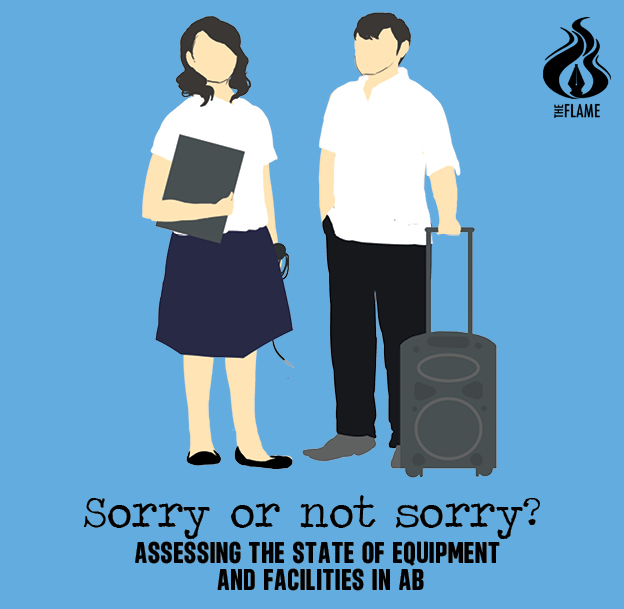By FATE EMERALD M. COLOBONG and PEACH ARIANNA P. MANOS

A RECENT opinion article in the Flame talked about the “sorry state” of facilities and equipment in the Faculty of Arts and Letters (AB). However, AB Dean Michael Anthony Vasco begged to disagree.
READ: The sorry state of affairs in AB
“Tayo lang ang kolehiyo, I think, na lahat ng classrooms ay may flat screen TV, and yet you say na it’s a ‘sorry state.’ […] bakit tayo lang ang may flat screen TV sa 27 classrooms natin? Tapos lahat merong multimedia projector, lahat merong built-in microphone,” he said.
On AB equipment
In Academic Year (A.Y.) 2013 to 2014, AB procured ten 52-inch LED TVs for classrooms. Four academic years later, all 27 rooms in AB already have built-in televisions complete with the EZCast software, according to data given by the administration.
EZCast is a digital media player that allows users to mirror media content from smart devices and project it to high-definition televisions.
According to Dean Vasco, EZCast was the solution to the wear and tear problem with VGA and HDMI cables. However, wireless technology still poses some issues as it strongly depends on the wifi signal, prompting the administration to order HDMI and VGA cables for backup in case EZCast would not work.
Janelle Lorzano, a senior journalism student, noticed this development.
Lorzano said portable TVs were the only available equipment students could use during her freshman year, but now, she has seen a significant change in the use of built-in TVs in all classrooms, which have facilitated easier class discussions and activities.
“Every year, sinisigurado nila na may development sa mga equipment na in the end, the students will benefit,” she said.
However, for journalism senior Shayla Romero, although she has noticed that there is now an EZCast, sound system, and more microphones, they are sometimes defective.
“Maganda na merong EZcast, pero minsan kasi kapag high definition ang video, hindi siya kaya kahit naka-VLC player na. Napuputol-putol ang video tapos minsan pangit ang audio. Kahit na advanced na ‘yung EZcast, mas pipiliin pa rin ng mga professor na mag-projector kasi hindi naapektuhan ang quality ng video at masakit kasi sa batok ng mga nasa first row tingnan ang TV,” she explained.
She added that returning dysfunctional equipment to the Dean’s Office to have them replaced causes class disruption. Worsening this is the tedious process of setting up equipment, especially for those who do not have enough technical know-how.
Both Lorzano and Romero noticed a scarcity in the number of equipment and suggested that it should be increased and made available inside classrooms to avoid inconvenience and class disruptions.
However, Dean Vasco said the number of equipment AB has is enough.
“Well actually they are enough [equipment]. Ang problema talaga natin is the wear and tear of the equipment. If you noticed, year in and year out, we are acquiring new equipment but we are also retiring as many,” he said.
“One aspect is the discipline. I am not ruling out the wear and tear kasi talaga namang naluluma ang mga equipment, pero para magpalit tayo taon taon, there’s something wrong. Kasi ang wear and tear ng equipment, it takes 3 to 4 years, pero kung taon taon nasisira, bakit ganoon ‘yung nangyayari? So tignan din natin ang end user,” the dean added.
Fewer students, limited resources
Aside from the wear and tear of equipment, another problem is the limited resources to acquire new equipment and improve facilities due to the lower number of enrollees this year stemming from the transition of to K to 12.
Part of the tuition fee paid by Artlets is the 800-peso Special Development Fund (SDF), which is used for equipment and facilities in the Faculty.
To compensate, the admin does periodic checks to assess if there are equipment that need to be repaired. At the end of the month, those that are considered “beyond repair” would be sent to the central technicians of the University for replacement, which would require another tedious process unless in cases of emergency, according to the dean.
He added that global standards in equipment and facilities must be adapted to the local context and that the Faculty must not be compared with other universities with better resources.
“Dapat ang principle diyan ay ‘Think globally, act locally.’ Number one, we have very limited resources. Sabi ninyo ay ‘A world-class liberal arts college deserves world-class facilities.’ [Ang] tanong ko, magkano ba ang ating resources?” Vasco said.
AB is not only limited in resources, but also in manpower.
Mr. Richard Silva is the only audiovisual technician in the Faculty. He maintains almost all technical equipment because computer technicians, even if there are three in AB, are only adept in addressing computer concerns, Silva said.
Further, he stated that the problem is in how students handle the borrowed equipment. “Lately na-[realize] namin na ang cause kaya laging nasisira ang mga equipment natin is hinihiram [ng students].”
Although there are equipment already built and set up inside classrooms, Artlets still have to borrow laptops, cables, projectors, and speakers, among other things from the Dean’s Office on the second floor of the St. Raymund de Peñafort building.
To solve this, Silva said the admin is planning to set up desktop computers in each classroom in AB complete with all needed equipment so that students would not need to borrow from time to time.
He added that this will empower technicians since it will enable them to help in maintaining and monitoring the computer units.
“Mabo-boost ngayon kaming apat na technician dito kasi computer na siya, at ‘yung mga computer technician, kaya na nilang i-handle ‘yan. Hindi kagaya ngayon na laptop lang siya, so kapag may mga problema sa equipment, sasabihin nila na ‘Uy kay Richard ‘yan, balikan ninyo ng alas dose,’” he said.
Silva’s schedule is from 12 n.n. to 9 p.m. from Tuesday to Saturday. In the morning, no audiovisual technician is available in AB. “Hindi 100 percent ‘yung assistance,” he said.
Another project the admin is planning is to custom build all equipment in a way that HDMI and VGA cables will already be fixed and hooked to the television in all classrooms.
However, both projects are still in process and their completion will depend on the budget of the Faculty.
On AB facilities
The first and second floors of St. Raymund’s building are known to be a home for Artlets. But with the growing number and demands of the Artlet community, have the buildings’ facilities been able to cope with the changing times?
In A.Y. 2014-2015, the Students Welfare Development Board office and Room 121 were renovated. The following year, there was also a renovation of the guidance counselors’ office along with the procurement of its furniture.
Just recently, the College of Commerce turned over Room D and its mezzanine to AB to give the Faculty additional facilities for its new batch of creative writing students. The mezzanine now houses the English and Philosophy Departments.
AB also takes pride in having three computer rooms: the computer lab, the eLeAP room, and the Learning Resource Unit.
Aside from the renovations, there is also the yearly procurement of air conditioning units and frequent acquisition of classroom chairs because of wear and tear.
Moreover, classroom reservation for students’ activities remains to be an issue since classrooms in AB are earmarked only for regular and special classes. It can be difficult to reserve rooms for non-academic activities, although there are some periods between class hours where classrooms can be used for other purposes.
With regards to the Faculty having its own audiovisual room (AVR), Dean Vasco said it would require added facilities and extra space—two things the building lacks.
On the state of restrooms
The students’ concerns on the state of restrooms in the St. Raymund’s building echoes the loudest in the hallways.
Maricar Yabut, team leader of the AB maintenance staff, has been working in the building for 13 years and said her only concern is the water system in restrooms.
“Ang pinaka-concern talaga ay ‘yung CR dahil ‘yung tubig, recycled water. Kahit anong linis namin, ‘yung amoy ng recycled water ay mabaho, tsaka ‘yung nilalabas niya ‘di ba parang ang itim. Kahit anong gawin naming linis, kahit minu-minuto mo linisan, kung ganon ang tubig, hindi [malilinis],” she said.
Same goes for other maintenance staff like Eriberto Buce and Rayman David. They said the use of recycled water in the restroom and in cleaning some parts of the building have had visitors and students complaining.
“Napansin ko lang is ‘yung tubig nga natin kasi marami ring nagrereklamo. ‘Pag maglilinis ako ng CR, sasabihin ng estudyante, ‘Kuya, bakit ang baho ng tubig niyo?’” David said.
Dean Vasco said they tried requesting the use of fresh tap water for the restrooms, but the request was rejected for environmental reasons.
“We have to understand that even water is a limited resource. So para namang sayang nga naman ‘yung tap water na gagamitin mo lang naman pang flush, e bakit hindi na lang ‘yung recycled water. ‘Yun ang point doon,” Vasco said.
As for the renovation of restrooms, the dean said it has to be a mutual decision and collective effort with the College of Commerce because AB shares the same building with them.
“Siguro we can coordinate with the College of Commerce. Baka gusto na rin nilang magpa-renovate ng CR kasi we belong to the same building, and ang CR naman natin ay hindi exclusive. Ang mga AB gumagamit sa taas, ang mga Commerce gumagamit sa AB,” Vasco said.
Final assessment
In the end, Dean Vasco’s assessment of the state of AB equipment and facilities remained “not sorry.”
“I just want to emphasize a sense of shared responsibility, co-ownership, and careful use of facilities… we are not blaming anyone here, pero dapat [equipment and facilities are] shared responsibilities of the administration, students, and faculty,” he said.
However, some Artlets think otherwise.
“For me, it’s in a very sorry state… first of all, ‘yung classrooms, hindi nila ma-accommodate ‘yung students. Kailangan pa naming hintayin matapos ‘yung morning section ng Asian Studies. Tapos ‘yung CR ng girls, sira ‘yung doors. walang bidet, ‘di nag-fa-function ‘yung sink,” journalism freshman Jessica Asprer said.
Anna Miranda, first year behavioral science student, shared the same sentiment regarding the facilities.
“‘Yung chairs mga pasira na, saka main problem ‘yung comfort room kasi minsan walang tubig at wala ring bidet,” she said.
The two Artlets argued that, since the building is over five decades old, the facilities and equipment in AB are rusty and thoroughly used to the point where they are defective.
For Dean Vasco, the state of facilities does not depend on the age of the building.
“We have to admit that our building is not that young, but I don’t think that simply because we have an old building is hindi na siya conducive. You should go to much older universities and look at their classrooms… kasi ang idea, ‘pag luma hindi na conducive. Hindi naman ganoon,” he stressed. F



